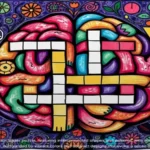The NYTimes Connections game has become a highly popular way for puzzle lovers to engage their minds while having fun. Whether you’re a seasoned player or just starting, there’s no denying that the thrill of solving puzzles with the bonus of daily challenges keeps us coming back. But, like any game, some strategies can help improve your chances of winning and increase your enjoyment. In this article, we’ll explore NYTimes Connections hints for today, providing tips, tricks, and insights to help you outsmart the game and boost your puzzle-solving skills.
What is NYTimes Connections?
Before we dive into today’s hints, let’s take a quick look at the NYTimes Connections game. It’s a word puzzle game in which players sort a set of 16 words into four categories based on shared themes or connections. The challenge lies in identifying these connections and grouping the words accordingly.
Each puzzle presents 16 words, and the objective is to divide them into four groups of four words. The connections between words can be based on a variety of themes, such as:
- Categories (e.g., animals, fruits, countries)
- Shared characteristics (e.g., colors, shapes, professions)
- Pop culture references (e.g., movies, TV shows, celebrities)
- Historical periods or events
The game is typically timed, adding a level of urgency. The key to mastering NYTimes Connections is practice, pattern recognition, and learning how to think outside the box.
How to Approach Today’s NYTimes Connections Puzzle
If you’re looking for NYTimes Connections hints for today, there are several ways you can approach the puzzle and increase your chances of solving it correctly. Here are some general strategies that will help you outsmart the game:
1. Start with the Obvious Connections
When you first look at the 16 words, don’t rush into making decisions. Start by scanning the words for any obvious connections. This could be based on:
- Synonyms or antonyms (e.g., “cold” and “chilly”)
- Shared categories (e.g., names of animals, cities, or colors)
- Common themes (e.g., words related to nature, seasons, or emotions)
You’ll already have a leg up by quickly identifying the most apparent connections. This will also give you a clearer sense of which words are left over, helping you narrow down the remaining possible connections.
2. Use the Process of Elimination
If you can’t find the perfect connection immediately, try eliminating combinations that don’t make sense. Cross out words that don’t fit with others, which will help you narrow down the possibilities. By doing this, you’re essentially making the puzzle easier to solve because you’re cutting down the number of possible combinations.
For example, if you have a list of words you suspect might belong together but are unsure, try pairing them with words from the other groups to see if they fit. This helps eliminate any doubts and streamlines your thought process.
3. Group Words Based on Categories You Know Well
Sometimes, the connection between words is something you’re already familiar with. For example:
- Colors: Red, blue, green, yellow.
- Types of animals: Dog, cat, elephant, lion.
- Famous historical figures: Abraham Lincoln, Cleopatra, Winston Churchill, Genghis Khan.
If any of the words are ones you know well, group them together. Being familiar with the subject matter can give you an edge in quickly recognizing the connection.
4. Look for Word Associations
Words that share a more abstract connection can often be grouped as well. These connections may not be immediately obvious but can often be guessed if you think about common word associations or even homophones. For instance:
- Sounds like: Words that sound alike or have similar phonetic qualities.
- Associated with a concept: Words that are commonly found together in the same context or idea (e.g., summer, beach, vacation, sun).
Paying attention to subtle associations between words will help you organize them into their correct categories.
5. Don’t Overthink It
One of the best pieces of advice when solving NYTimes Connections is not to overthink the connections. Sometimes the solution is simpler than it seems. If you find yourself stuck, take a break and return to the puzzle later. Your mind might make the connections more easily after stepping away for a while.
6. Consider Pop Culture References
The NYTimes often uses popular culture as a theme for some puzzles. This could include references to celebrities, movies, TV shows, and music. If you see any familiar names or terms, consider grouping them together. For example:
- Famous movie characters: Superman, Batman, Wonder Woman, Spider-Man.
- Popular TV shows: Friends, Seinfeld, The Office, Breaking Bad.
7. Try to Identify Themes Related to Time and History
Many NYTimes Connections puzzles include words tied to specific periods or historical events. This could be related to:
- Decades: The 1960s, the 1980s, the 2000s, etc.
- Historical events: The Civil War, the Great Depression, World War II, and the Space Race.
Knowing the context of these historical events or periods can help you identify the correct groupings and avoid confusion.
8. Check for Word Length or Letter Patterns
Another effective strategy is to look at the length of the words or their letter patterns. Sometimes, puzzles will group words by:
- Word length: Words that are similarly long or short may fit together.
- Common prefixes or suffixes: Words with the same starting or ending letters can be grouped together (e.g., “un-” words or words that end with “-ing”).
9. Play Regularly to Build Pattern Recognition
Like any game, the more you play, the better you’ll become. Regularly solving NYTimes Connections puzzles will help you become familiar with the types of connections commonly used in the game. This means you’ll be able to recognize patterns faster and more easily, improving your performance over time.
Advanced Tips for Solving NYTimes Connections Puzzles
Once you’re comfortable with the basics, you can start implementing more advanced strategies. Here are some tips to take your NYTimes Connections skills to the next level:
1. Look for Double Meanings or Puns
Sometimes, the connection between words can be a play on words, a pun, or a word that has more than one meaning. For instance:
- A word like “light” can refer to both “light” as in weight and “light” as in illumination.
- “Bark” can refer to the sound a dog makes or the outer layer of a tree.
Being open to these possibilities can help you find connections that may not be immediately obvious.
2. Think About Synonyms and Related Terms
Instead of focusing solely on literal connections, think about words that could be related by synonyms or slight variations. For instance:
- “Quick,” “fast,” and “rapid” are all synonyms, so they could form a group based on that theme.
- “Anger,” “rage,” and “fury” could also belong in the same group.
3. Use Your Knowledge of Word Origins
If you’re a fan of etymology or have a strong grasp of word origins, you can use this knowledge to identify connections based on how words are derived. For example, words derived from Latin or Greek might have a common root or theme.
4. Break Down Complex Connections into Simpler Groups
Some connections might seem complex at first, but breaking them down into smaller, simpler groups can often help. Look for one word that stands out and try to group it with others that have a similar characteristic.
5. Collaborate with Friends or Fellow Players
Lastly, if you’re stuck, don’t hesitate to collaborate. Ask friends, family, or fellow players for their insights. Sometimes, someone else can see a connection that you missed, making the puzzle-solving experience even more fun and social.
Conclusion: Mastering NYTimes Connections with Today’s Hints
Mastering the NYTimes Connections game is all about practice, strategy, and staying open to new ways of thinking. By starting with obvious connections, using the process of elimination, and considering a variety of themes—from pop culture to historical events—you can improve your puzzle-solving skills over time.
Each day presents a new challenge, and with these tips and hints, you’ll be ready to face whatever connections come your way. So, whether you’re playing today’s puzzle or tomorrow’s, remember to stay focused, think creatively, and have fun!
Learn more Connections Hints


